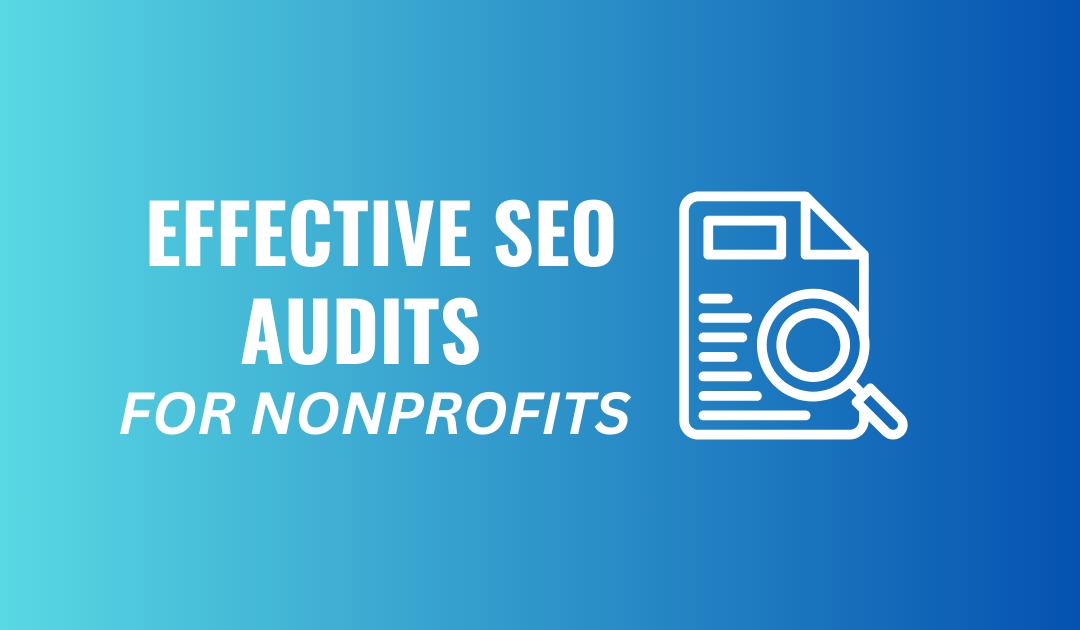An SEO audit can drive significant improvements in visibility, engagement, and donations for nonprofits.
For nonprofits that don’t regularly keep their SEO practices up to date, often a few changes can make a big impact. I’ve worked with nonprofits to increase organic traffic by as much as 50% within a few months by identifying critical issues and implementing effective SEO strategies. Whether you’re just starting or looking to refine your SEO approach, this audit process can help your organization improve search visibility and connect with more people.
Here’s a streamlined guide with key steps to audit your SEO effectively.
For deeper insights, check out the SEO for Nonprofits guide.
Key Takeaways
Define clear goals and KPIs to measure SEO progress.
Use tools like Google Search Console to identify technical issues that hinder performance.
Optimize content, titles, and descriptions to enhance rankings and engagement.
Regularly review backlinks to maintain high-quality connections and improve authority.
10 Nonprofit SEO Audit Steps
1. Set Goals and KPIs
Start with clear objectives such as increasing traffic, donations, or volunteer engagement. Track organic traffic, top pages by organic traffic and conversion rates in Google Analytics and keyword rankings in SEMrush and/or the Google Search Console.
KPIs help measure each step’s effectiveness—see our SEO guide for examples.
2. Check Technical SEO with Google Search Console
Use the Google Search Console to identify crawl errors, broken links (404 errors), and slow pages. Optimize speed and mobile friendliness using PageSpeed Insights. Be sure to confirm HTTPS security for trust and rankings. And this can make a big impact if there’s an issue – ensure you don’t have multiple versions of your website.
Technical SEO fixes are essential for keeping your site accessible.
3. Review Your Sitemap
Ensure your sitemap reflects current site structure and submit it in Google Search Console and Bing Webmaster Tools.
For easy sitemap updates if your website uses WordPress, use a plug in like Rankmath or Yoast (I prefer Rankmath but it’s not worth switching if you’re already using Yoast).
As an advanced tactic, you can add schema markup to your site to enhance search visibility and increase chances for rich snippets. Check for implementation with Google’s Structured Data Testing Tool.
4. Evaluate Domain Authority with Moz
Use Moz’s Domain Authority Checker to check your Domain Authority (DA). A score over 40 signifies strong authority, improving ranking potential. If you have a score of less than 30, you should consider a backlink strategy. If you have a score of over 60, you should consider targeting higher-traffic keywords.
5. Analyze Competitors with SpyFu
Study competitors’ keywords and SEO strategies using SpyFu. You can plug in your site to see some competitors for keywords or add the competitor sites/nonprofits that you know. Identify high-value keywords or content gaps to target. You can look at their backlink profiles and content strategies to identify areas for competitive advantage.
Try to get ahead of the competition and avoid common errors—see nonprofit SEO mistakes.
6. Check SEO Toolkit with Wappalyzer
Analyze your site’s tools with Wappalyzer to find any missing resources, such as SEO plugins (Yoast or Rankmath), analytics, or security features that help maintain competitive SEO.
7. Optimize On-Page Elements
Ensure all pages have unique, descriptive title tags and meta descriptions within Google’s character limits. Organize headings (H1 for main topics, H2/H3 for subsections) and add alt text to images for accessibility and SEO. You will need to download it, but you can use screaming frog to audit your site for free and it will check the on page elements and more.
By doing a better job with your SEO titles (keeping it under 55 characters, including a target keyword upfront, perhaps including the year if it was just updated) and meta descriptions (under 155 characters, including the target keyword, starting with an action word and very “clickable”) you can often see a big boost in traffic.
For tips on improving content, read nonprofit website copywriting.
8. Conduct Keyword Research
Use Google Keyword Planner or SEMrush to find relevant primary and long-tail keywords like “donate to [cause] in [city].” Check competitors’ keywords in SEMrush or SpyFu to identify strategic gaps. For free, you can also use Wordstream or Ubersuggest (3 times daily for free) for further ideas.
9. Perform a Content Audit and Link Top Pages
Use Google Analytics to locate high-traffic pages. Especially if you haven’t updated in a while, you might be able to get a lot more traffic by updating old content with high SEO potential versus creating new content. Update content, link to newer pages and use your high traffic pages as SEO assets, and add internal links to boost engagement.
You can also use Moz’s Domain Authority Checker to check the authority of different pages. Try to find ways to link your top SEO pages to other key pages and more effectively spread out what’s referred to as your “link juice”.
10. Monitor Backlinks and Build Partnerships
Use Ahrefs or Moz to review backlinks and then reach out to relevant sites for partnerships. You should especially focus on this if your domain authority is less than 40. You can create shareable resources like guides or case studies to attract organic backlinks.
Ready to Boost Your Nonprofit’s SEO?
This SEO audit guide provides a robust foundation to improve visibility and engage supporters.
For expert assistance in performing a detailed audit, please get in touch.

